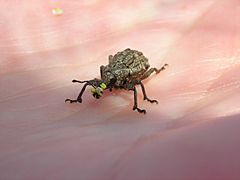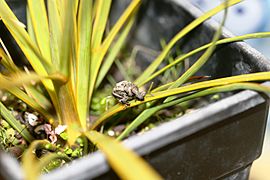Canterbury knobbed weevil facts for kids
Quick facts for kids Hadramphus tuberculatus |
|
|---|---|
 |
|
| Illustrated by Des Helmore | |
| Conservation status | |
| Scientific classification | |
| Kingdom: | |
| Phylum: | |
| Class: | |
| Order: | |
| Family: | |
| Subfamily: |
Molytinae
|
| Genus: | |
| Species: |
H. tuberculatus
|
| Binomial name | |
| Hadramphus tuberculatus (Pascoe, 1877)
|
|
| Synonyms | |
|
|
The Canterbury knobbled weevil (also known as the Spaniard weevil or Banks Peninsula speargrass weevil) is a very rare weevil. It lives only in the Canterbury area of New Zealand's South Island. For a long time, people thought this special insect was gone forever after 1922. But guess what? It was found again in 2004!
Contents
What Does the Knobbled Weevil Look Like?
The Canterbury knobbled weevil, or Hadramphus tuberculatus, is a type of weevil that cannot fly. It has a bumpy, or "knobbled," back.
Size and Color
These weevils are about 11.7 to 16.3 millimeters long. That's roughly the length of a small paperclip! They are also about 6.5 to 8.3 millimeters wide. Their bodies are dark brown, with scales that look greyish-brown.
How Was This Weevil Named?
This weevil was first officially described in 1877. A scientist named Francis Pascoe gave it its scientific name. He used weevil samples that were collected in Canterbury.
Why Is This Weevil So Rare?
In the 1870s, the knobbled weevil was quite common across the Canterbury Plains. However, its numbers started to drop quickly.
Why Did They Disappear?
One big reason for their disappearance was the loss of their favorite plant. Farmers removed a plant called speargrass (Aciphylla). This plant was the weevil's main home and food source. Also, new animals like European rats arrived. These rats hunted and ate the weevils.
Rediscovery and Protection
The last time anyone saw a knobbled weevil was in 1922. For many years, people thought they were extinct, meaning completely gone from the world. But in late 2004, something amazing happened! Research students from the University of Canterbury found them again. They discovered a small group of weevils near Lake Tekapo at Burkes Pass.
Today, the New Zealand Department of Conservation lists this weevil as nationally endangered. This means it's at high risk of becoming extinct in New Zealand. The IUCN Red List, which tracks endangered species worldwide, calls it critically endangered.
How Many Are Left?
From 2009 to 2011, scientists studied the weevil population at Burkes Pass. In 2009, they estimated there were only about 138 weevils. Sadly, this number went down to just 76 by 2011. This shows how important it is to protect these special insects.
Gallery of images







